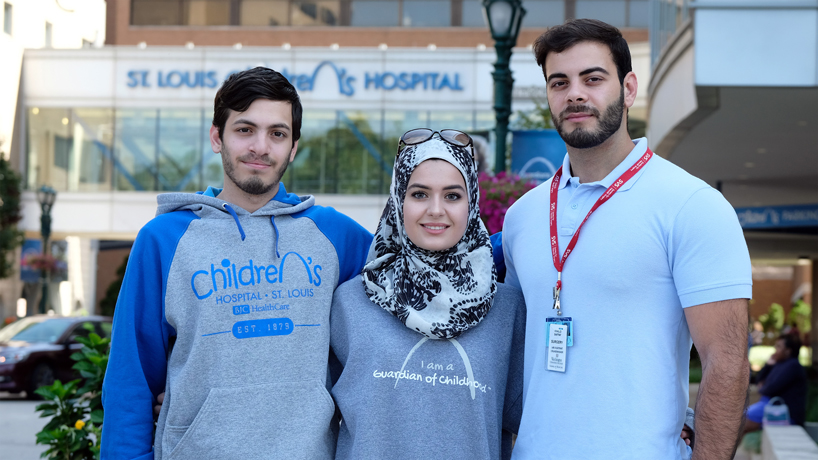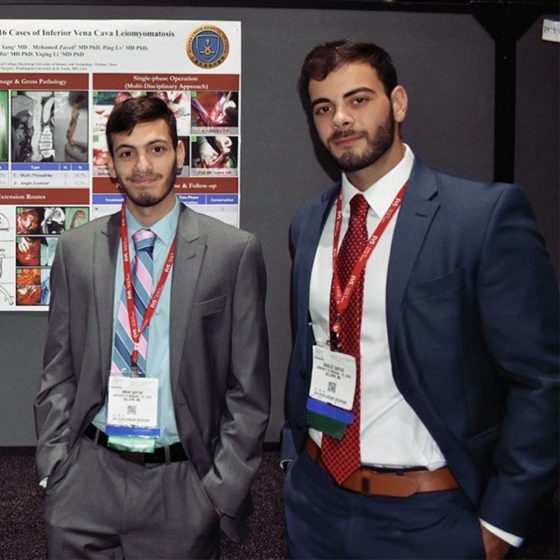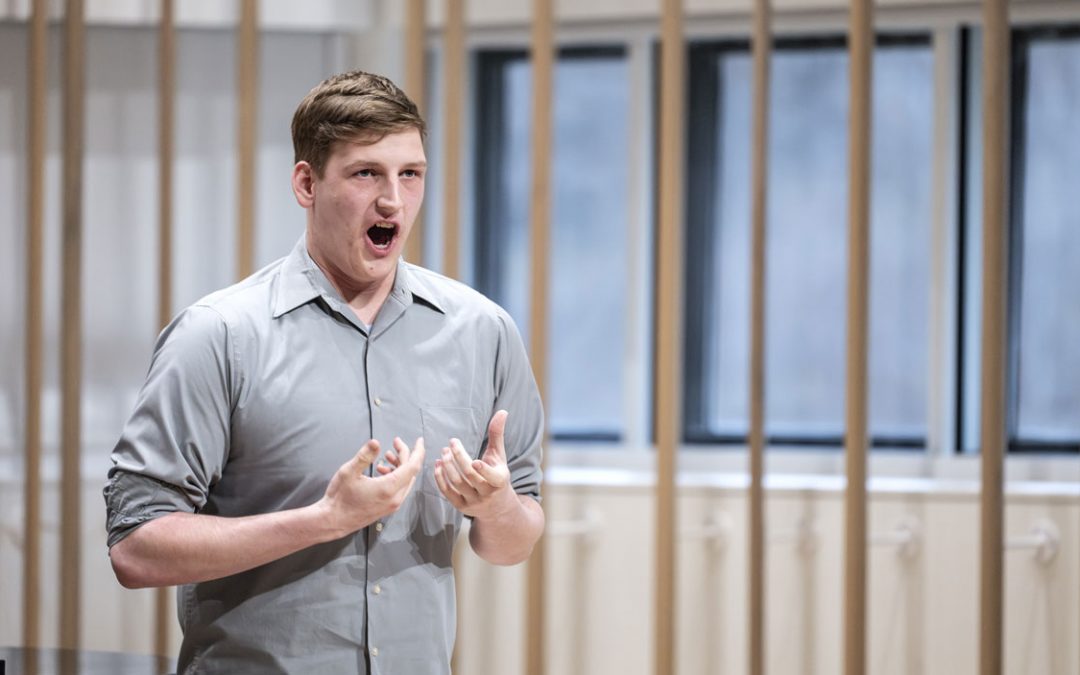
UMSL pre-med students Omar, Alaa and Khalid Saffaf give back to St. Louis Children’s Hospital after the kindness and top-notch care Omar received for his cleft lip and palate. The experience inspired the three to pursue careers in medicine and led Omar and Khalid to conduct cutting-edge medical research. (Photo by August Jennewein)
After 22 years of the Saffaf siblings going to St. Louis Children’s Hospital to support their brother Omar through a dozen or so operations, it’s almost trite to call the whole experience “life altering.”
But truly it was and in more ways than one.
Born with a cleft lip and cleft palate, Omar needed multiple reconstructive surgeries. Now a young man, he’s just finishing treatment this year, which has been a big success.
With him every step of the way have been Khalid and Alaa, his older brother and sister, and their parents, of course.
But while the physicians were changing Omar’s life through treatment, something else was happening – the hospital environment was sparking the siblings’ interest in the world of medicine.
Now students at the University of Missouri–St. Louis, all three are pre-med, with Khalid and Alaa in their senior years of their biology majors and Omar in his junior year of his biochemistry and biotechnology major.
Throughout their college careers, they have continued their relationship with St. Louis Children’s Hospital as volunteers.
“It was our way of giving back to the hospital and showing our gratitude for everything they’ve done for us,” Khalid said.
They started by volunteering in the playroom, which offers children a play space outside of their hospital room. It’s equipped with everything from toys to video games and more.
“It’s a good way for them to forget about the hospital environment and focus mostly on being a kid,” Khalid said.
After gaining some experience, Khalid and Omar sought something more high-paced, so they began volunteering in the emergency room and eventually got bumped up to working with ear, nose and throat physicians and plastic surgeons.
“The cool thing was, I was actually working with the same surgeons that did my operations when I was kid,” Omar said. “It was literally the same exact team.”
Alaa decided to volunteer in same-day surgery, helping prep children for procedures, but eventually returned to the playroom.

Omar and Khalid Saffaf’s research projects and their story have landed them scholarships to extremely selective conferences this year, including the Society of Vascular Surgery conference in San Diego, California. They both were the first pre-med students to be accepted and awarded scholarships to the conference since the first and only pre-med student ever accepted in 2014. (Photo courtesy of Saffafs)
“They make us actually do rounds and check on families, and I really enjoy doing that,” said Alaa, who became close with a 3-year-old girl with leukemia. “She really didn’t have a lot of family coming and visiting her. I was up every week just spending time with her. We ended up getting really close, but sadly she didn’t make it.”
While the Saffafs have certainly experienced loss, they also have gotten to see many patients beat diseases like cancer and ring a bell in symbolic victory as doctors, nurses and hospital staff celebrate another life saved.
Alaa, who loves working with the children, now volunteers in the neonatal intensive care unit and intends to become a NICU physician. Her brothers, on the other hand, have found themselves headed down a different medical path.
Around the time Omar and Khalid were hunting to join a research lab, a close relative was diagnosed with Type 2 diabetes and had begun experiencing slight leg pain.
Through online research, they suspected their relative might have peripheral artery disease, of which diabetics are at higher risk of developing. PAD is a narrowing of the peripheral arteries due to the buildup of plaque. A doctor would later confirm their relative had a mild case.
Fatefully, Omar and Khalid landed interviews for student research spots in Dr. Mohamed Zayed’s lab at Washington University School of Medicine. Zayed specializes in vascular surgery.
“We told him our story,” Khalid said. “We were able to do research with him because we had clinical experience at Children’s Hospital – over 150 hours.”
The two brothers were assigned different research projects.
Khalid researches an innovative method used to detect blood flow in diabetics with severe PAD who have developed critical limb ischemia. CLI is where blood flow is blocked to extremities and often leads to amputation. Essentially, he wants to determine where surgical site healing can be at its best.
“We’ve found that there’s a correlation between healthy blood flow to the surgical site and whether or not a patient will develop an infection post-operation,” Khalid said.
Currently, surgical site healing is predicted, but newer technology can now be used to actually assess this beforehand. Khalid is studying one such technique using a novel device that allows doctors to detect where enough blood is flowing to support proper healing. Using the device prior to performing an operation could help mitigate infection and avoid reoperations.
“In certain cases, patients can enter into a vicious cycle of one operation to another,” Khalid said. “Our research is trying to prevent that from happening.”
Omar’s research tries to prevent limb loss altogether in patients who have diabetes and PAD. He has reviewed recent studies that determine the effects of novel cell-based therapies thought to possibly improve blood flow when injected into the leg.
“If you create better blood flow, you have a better chance of limb preservation and survival,” said Omar, who noted that patients who undergo amputations are 50 percent more likely to die within five years of the procedure.
It’s why amputation is considered a last resort to alleviate pain from an infection in the foot or leg. It’s also why Omar’s positive results so far are very encouraging.
“When you use this cell-based therapy, the leg actually starts to heal,” he said, “and you will see it prevent the infection from growing because it’s getting more blood to the area.”
It should be noted that PAD does not have a cure, but that this therapy does show promising results for halting further infection.
The brothers’ research projects and their story have landed them scholarships to extremely selective conferences this year. They both attended the Introduction to Academic Vascular Surgery in April in Tampa, Florida. It accepts only 15 med and pre-med students combined, 15 research fellows and 15 residents. Both Khalid and Omar earned spots as pre-med students.
Khalid also presented his findings at the Society of Vascular Surgery conference this summer in San Diego, California, which accepts 10 student applications worldwide. Omar attended the conference as well. They both were the first pre-med students to be accepted and awarded scholarships to the conference since the first and only pre-med student ever accepted in 2014.
The Saffafs say a lot of people are surprised when they hear they are proud UMSL students.
“I’m always trying to tell people it has nothing do with Ivy League schools and prestige,” said Khalid of their success so far. “If you have passion for something, regardless of what you’re doing, and a strong work ethic, you’re going to get to something. But you’ve got to put that passion and work into what you’re doing. That’s what separates us from other volunteers and researchers.”
Khalid and Alaa will graduate this December. Omar has a year left. All three are currently preparing to take the Medical College Admission Test this fall and will be applying for medical school in 2018.















